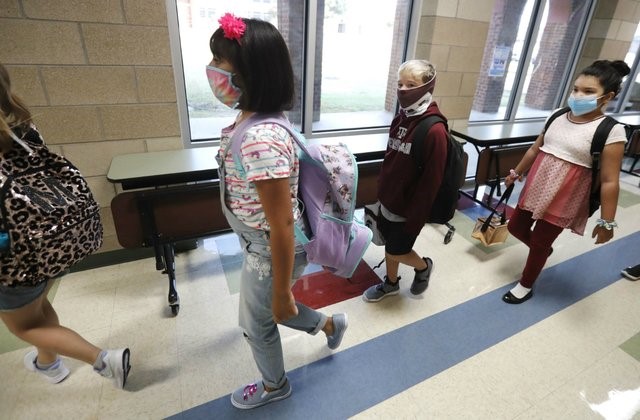By Lauren Camera, Senior Education Writer, US News & World Report, Aug. 12, 2020, at 9:47 a.m.
WHEN PRESIDENT Donald Trump signed a series of executive orders aimed at providing economic relief to blunt the repercussions of the ongoing coronavirus pandemic, the action eviscerated high-level negotiations on a bill to provide a major new infusion of federal support, leaving the country’s public schools system reeling as educators in some states began receiving students back to class without a cent of additional funding.
In the run-up to Trump’s executive orders, signed Saturday, dozens of national education organizations had been clamoring for a new federal bailout to cover significant budget cuts – some upward of 25% – stemming from gutted state and local revenue that make up the bulk of school budgets.
The Council for Chief State School Officers, which represents state school chiefs of all political persuasions, estimates public schools need as much as $245 billion to reopen safely amid a pandemic and to provide additional academic and social and emotional support to recover from the dramatic closures that occurred across 14,000 school districts in March. But signing the executive orders, which focus on payroll tax, rent and student loan debt – and not K-12 education – provided political cover for White House officials and Senate Republicans to step away from unproductive negotiations with House Democrats without addressing school needs.
“The use of executive orders exacerbates and complicates this political divide and does nothing to drive relief in a manner that helps schools,” says Noelle Ellerson Ng, associate executive director of advocacy and government at AASA, the School Superintendents Association. “His use of executive order unchecked complicates and makes even more partisan these negotiations.”
With most members of Congress back in their home districts this week, education organizations are pleading with them to return to the negotiating table.
In a letter to White House officials and congressional leaders Tuesday, Ellerson Ng urged them to resume negotiations and relayed the findings from an Aug. 3 survey of superintendents regarding the costs associated with reopening schools in-person, online or with a hybrid model.[
“When asked to explain the types of costs incurred when reopening under any of the models, the school leaders gave a clear indication that the costs are significant, enduring, and well beyond regular school costs,” she wrote. “Their responses illustrate the need for investment and debunk the illâ€informed idea that schools are in a position to do this now or, even more absurdly, that schools are saving money when not physically open during the pandemic.”
The National Association of Elementary School Principals, which represents the country’s elementary and middle school principals, slammed the dissolved negotiations in a statement Tuesday: “Districts and schools are facing school reopening decisions that could shape the educational prospects of millions of students, affecting the country for decades to come,” its leadership said. “There is no way around it: Failure by the Trump administration and congressional leaders to provide significant funding to support safe school reopenings would be abandoning America’s K-12 schools at their most perilous moment.”
Earlier this week, the American Federation of Teachers launched a half a million dollar radio and TV ad campaign in the Washington, D.C., market that hammers Senate Majority Leader Mitch McConnell of Kentucky and the president for walking away from the negotiations on a new round of stimulus funding.
“For more than two months, Mitch McConnell and the White House have been shouting that they want schools and the economy to reopen, while shamefully sitting on their hands and refusing to act on an actual relief package,” AFT president Randi Weingarten said in a statement. “Signing executive orders that don’t address our real needs, including support for schools and child care, while effectively cutting unemployment and threatening Social Security, is a cynical and cruel political ploy.”
The biggest ticket items for which schools need financial support include purchasing personal protective and sanitizing equipment for staff and students, reconfiguring school spaces to meet social distancing guidelines, hiring new staff to accommodate new school schedules, providing students with computers, pads or other equipment for remote learning and ensuring families have access to the internet.
Before negotiations fell apart, House Democrats passed a sweeping $3 trillion bill that included roughly $90 billion for K-12 education, while Senate Republicans proposed about $70 billion – both figures less than what education organizations have estimated is needed.
Notably, the stalled negotiations come as the American Academy of Pediatrics reports 179,990 new COVID-19 cases in children from July 9 to Aug. 6 – a 90% increase over the four weeks – and on the heels of new information from the Centers for Disease Control and Prevention that children do, in fact, contract and spread the virus, some as efficiently as adults, and are at risk of developing severe cases.
